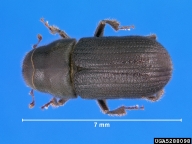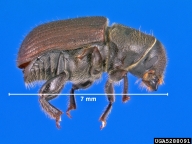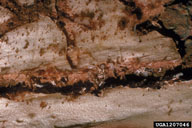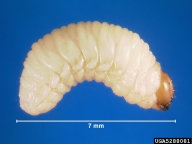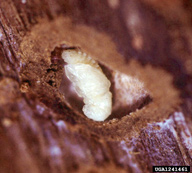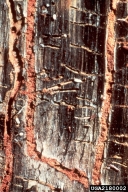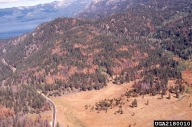Jeffrey pine beetle
Dendroctonus jeffreyi Hopkins, (Coleoptera: Curculionidae, Scolytinae)
Orientation to pest
Jeffrey pine beetle, Dendroctonus jeffreyi Hopkins, is a native North American bark beetle that attacks only Jeffrey pine (Pinus jeffreyi Grev. and Balf.) and it is that tree's most serious insect pest. This pine beetle occurs in the Sierra Nevada wherever Jeffrey pine is present. In most cases this beetle occurs at low densities and attacks only small numbers of slow growing trees with reduced vigor. However, large outbreaks can occur when forest conditions are favorable, especially during extended droughts. Adults emerge from infested trees in April or May. Mass attack is initiated by colonizing beetles, which release aggregation pheromones. Females bore in and excavate a vertical gallery where they lay their eggs. The oviposition gallery is packed with boring dust, and larvae later form short individual lateral tunnels where they feed. Jeffrey pine beetles overwinter as larvae or as pupae in chambers excavated at the end of larval galleries. Depending on local climate there are one or two generations per year. Beetles infect trees with a blue-stain fungus, which kills the tree by clogging the tree's vascular system. Signs of attack include pitch tubes on the mid or lower trunk. In weak trees pitch tubes may be absent.
Hosts commonly attacked
This beetle attacks only Jeffrey pine (P. jeffreyi).
Distribution
Jeffrey pine beetle is found within the range of Jeffrey pine, principally in California, with the exceptions of the San Jacinto, Santa Rosa, and Luguna mountain ranges of southern California, where this bark beetle has not been observed.
Images of Jeffrey pine beetle
| Figure 1. Adults of Jeffrey pine beetle, Dendroctonus jeffreyi | Figure 2. Eggs of Jeffrey pine beetle in oviposition gallery (above dark line of gallery) | Figure 3. Larva of Jeffrey pine beetle, removed from gallery | |
| Figure 4. Pupa of Jeffrey pine beetle | Figure 5. Galleries of adults (vertical) and larvae (horizontal) of Jeffrey pine beetle | Figure 6. Pines killed by Jeffrey pine beetle near Lake Tahoe, California |
Important biological control agents related to this pest species
Natural enemies of this bark beetle have received little attention, but likely are similar to those groups attacking western pine beetle (Dendroctonus brevicomis LeConte).
Web links for information on Jeffrey pine beetle
- Fact Sheet | Nevada Division of Forestry, State of Nevada
- Decayed Wood Advisor Page | USDA Forest Service and US Fish & Wildlife Service
- Fact Sheet | University of Nevada at Reno Cooperative Extension
Provides information about bark beetles in the Lake Tahoe Basin
Articles
- Smith, R. H., B. E. Wickman, R. C. Hall, C. J. DeMars, and G. T. Ferrell. 1981. The California pine risk-rating system: its development, use and relationship to other systems, pp. 53-69. In: Hedden, R.L., S. J. Barras, J. E. Coster. (Technical coordinators). Hazard-rating systems in forest insect pest management: symposium proceedings. Athens, Georgia, July 31-August 1, 1980. General Technical Report WO-27, USDA Forest Service, Washington, DC.
- Smith, S. L., R. B. Borys, and P. J. Shea. 2008. Jeffrey pine beetle. USDA Forest Service, Forest Pest Leaflet 11. 7pp.
